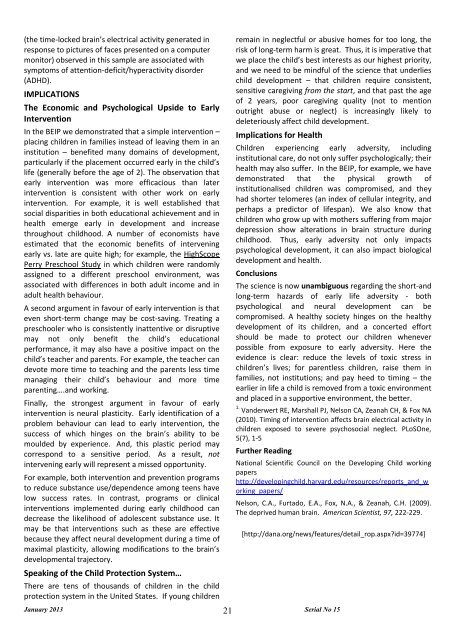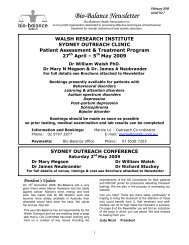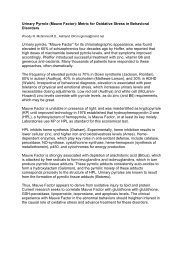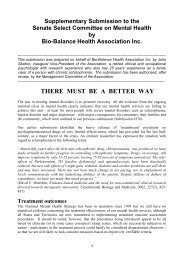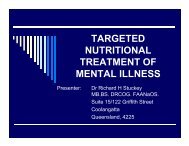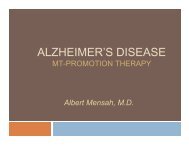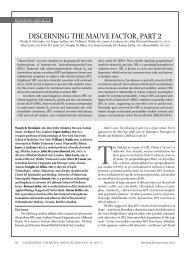Download PDF - Bio-Balance Health
Download PDF - Bio-Balance Health
Download PDF - Bio-Balance Health
- No tags were found...
You also want an ePaper? Increase the reach of your titles
YUMPU automatically turns print PDFs into web optimized ePapers that Google loves.
(the time-locked brain’s electrical activity generated inresponse to pictures of faces presented on a computermonitor) observed in this sample are associated withsymptoms of attention-deficit/hyperactivity disorder(ADHD).IMPLICATIONSThe Economic and Psychological Upside to EarlyInterventionIn the BEIP we demonstrated that a simple intervention –placing children in families instead of leaving them in aninstitution – benefited many domains of development,particularly if the placement occurred early in the child’slife (generally before the age of 2). The observation thatearly intervention was more efficacious than laterintervention is consistent with other work on earlyintervention. For example, it is well established thatsocial disparities in both educational achievement and inhealth emerge early in development and increasethroughout childhood. A number of economists haveestimated that the economic benefits of interveningearly vs. late are quite high; for example, the HighScopePerry Preschool Study in which children were randomlyassigned to a different preschool environment, wasassociated with differences in both adult income and inadult health behaviour.A second argument in favour of early intervention is thateven short-term change may be cost-saving. Treating apreschooler who is consistently inattentive or disruptivemay not only benefit the child’s educationalperformance, it may also have a positive impact on thechild’s teacher and parents. For example, the teacher candevote more time to teaching and the parents less timemanaging their child’s behaviour and more timeparenting….and working.Finally, the strongest argument in favour of earlyintervention is neural plasticity. Early identification of aproblem behaviour can lead to early intervention, thesuccess of which hinges on the brain’s ability to bemoulded by experience. And, this plastic period maycorrespond to a sensitive period. As a result, notintervening early will represent a missed opportunity.For example, both intervention and prevention programsto reduce substance use/dependence among teens havelow success rates. In contrast, programs or clinicalinterventions implemented during early childhood candecrease the likelihood of adolescent substance use. Itmay be that interventions such as these are effectivebecause they affect neural development during a time ofmaximal plasticity, allowing modifications to the brain’sdevelopmental trajectory.Speaking of the Child Protection System…There are tens of thousands of children in the childprotection system in the United States. If young childrenremain in neglectful or abusive homes for too long, therisk of long-term harm is great. Thus, it is imperative thatwe place the child’s best interests as our highest priority,and we need to be mindful of the science that underlieschild development – that children require consistent,sensitive caregiving from the start, and that past the ageof 2 years, poor caregiving quality (not to mentionoutright abuse or neglect) is increasingly likely todeleteriously affect child development.Implications for <strong>Health</strong>Children experiencing early adversity, includinginstitutional care, do not only suffer psychologically; theirhealth may also suffer. In the BEIP, for example, we havedemonstrated that the physical growth ofinstitutionalised children was compromised, and theyhad shorter telomeres (an index of cellular integrity, andperhaps a predictor of lifespan). We also know thatchildren who grow up with mothers suffering from majordepression show alterations in brain structure duringchildhood. Thus, early adversity not only impactspsychological development, it can also impact biologicaldevelopment and health.ConclusionsThe science is now unambiguous regarding the short-andlong-term hazards of early life adversity - bothpsychological and neural development can becompromised. A healthy society hinges on the healthydevelopment of its children, and a concerted effortshould be made to protect our children wheneverpossible from exposure to early adversity. Here theevidence is clear: reduce the levels of toxic stress inchildren’s lives; for parentless children, raise them infamilies, not institutions; and pay heed to timing – theearlier in life a child is removed from a toxic environmentand placed in a supportive environment, the better.1. Vanderwert RE, Marshall PJ, Nelson CA, Zeanah CH, & Fox NA(2010). Timing of intervention affects brain electrical activity inchildren exposed to severe psychosocial neglect. PLoSOne,5(7), 1-5Further ReadingNational Scientific Council on the Developing Child workingpapershttp://developingchild.harvard.edu/resources/reports_and_working_papers/Nelson, C.A., Furtado, E.A., Fox, N.A., & Zeanah, C.H. (2009).The deprived human brain. American Scientist, 97, 222-229.[http://dana.org/news/features/detail_rop.aspx?id=39774]January 2013 21Serial No 15


